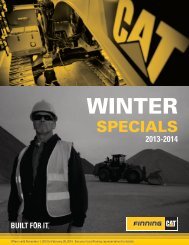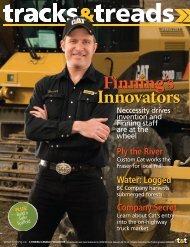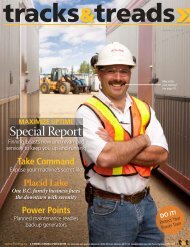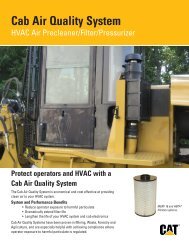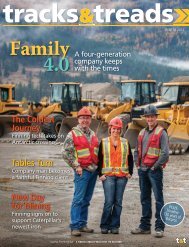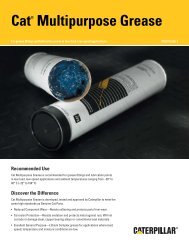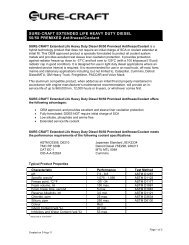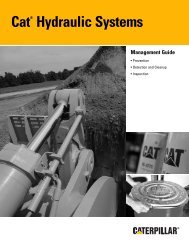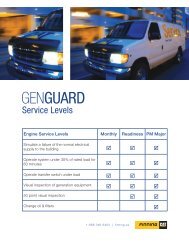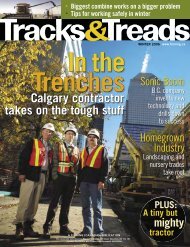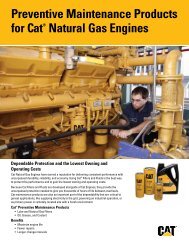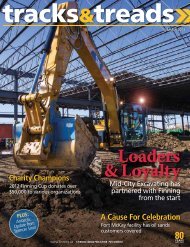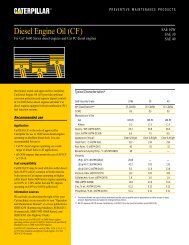Wanted Tour - Finning Canada
Wanted Tour - Finning Canada
Wanted Tour - Finning Canada
Create successful ePaper yourself
Turn your PDF publications into a flip-book with our unique Google optimized e-Paper software.
SPRING 2006 Volume 46, No. 1PUBLISHERRuth Kellyrkelly@venturepublishing.caASSOCIATE PUBLISHERJoyce Byrnejbyrne@venturepublishing.caEXECUTIVE EDITORJeff Howardjhoward@finning.caEDITORDan Rubinsteindrubinstein@venturepublishing.caLetters & FeedbackYOU WANTED TO KNOW about the Count On Us picture on page 42of the Winter 2005 issue. It is the opening of Endako Mines. Thepeople were brought in by bus and they are the ones on top of thehill looking into the pit. Also, you will notice the box on this truckis made of aluminum. Endako Mines at that time purchased l3769As and I spent one year as a resident there.Regards,Bill J. DavisKamloops, B.C.ART DIRECTORJennifer Windsorjwindsor@venturepublishing.caASSOCIATE ART DIRECTORVanlee Tranvtran@venturepublishing.caDESIGN & PRODUCTIONGunnar BlodgettCIRCULATION COORDINATOREsme Friesenefriesen@venturepublishing.caADVERTISING REPRESENTATIVEAnita McGillisamcgillis@venturepublishing.caCONTRIBUTING WRITERSRobin Brunet, David DiCenzo, Stewart Duncan,Will Gibson, Keith Haddock, Ross Henderson,Gene Kosowan, Jim Stirling, Shannon Sutherland,Bill Tice, Kerry TremblayCONTRIBUTING PHOTOGRAPHERSAND ILLUSTRATORSSylvie Bourbonnière, Stewart Duncan,Glen Durrell, John Gaucher, Keith Haddock,Jayson L. Hencheroff, Darrell Lecorre,Deon Nurkowski, Curtis TrentTracks & Treads is published to provide its readerswith relevant business, technology, product andservice information in a lively and engaging manner.Tracks & Treads is published forKEEP UP THE GOOD WORK. Y’all have a top-notch publicationhere. I’ve been driving the iron for 30-plus years, and there isno doubt in my mind – Cat is the best! In the area of customerservice, nobody else even comes close. Your magazine helps mekeep on top of what’s out there, and when asked what we need toget the job done, I’m a lot better informed, and this usually endsup with a call to our local <strong>Finning</strong> branch.Dennis KellyPrince George, B.C.<strong>Finning</strong> (<strong>Canada</strong>) byVenture Publishing Inc.#201, 10350-124 StreetEdmonton, Alberta T5N 3V9Phone: 780-990-0839Fax: 780-425-4921Contents © 2006 by <strong>Finning</strong> (<strong>Canada</strong>)No part of this publication should bereproduced without written permission.Tell us what you thinkTracks & Treads would love to hear from you. Tell us what you think of themagazine, its stories, its columns, its look. Tell us how we can improve themagazine and make it a more interesting read.Send your comments to executive editor Jeff Howard by e-mail at jhoward@fi nning.caor the old-fashioned way to: Jeff Howard, Tracks & Treads, <strong>Finning</strong> (<strong>Canada</strong>),16830 - 107 Avenue, Edmonton, Alberta, T5P 4C3www.finning.cawww.finning.caSpring 2006 • TRACKS & TREADS 5
GROUNDBREAKERNew Cats on the BlockNeed more power but concerned that will mean asacrifice in comfort? Need more versatility but worriedthat it could cost you some juice? Caterpillar’snew 319C LN excavator and 904B compact wheelloader ensure that neither of these conundrumswill come to pass.Dirt, not problems, is all you’ll dig up.The 904B replaces the 902 model and provesthe adage that bigger isn’t always better. At justcustomers, the 319C LN is the latest Cat in the20-tonne class of excavators. The new machinecombines the upper structure of a 318C (themodel it replaces) with the lengthier undercarriageof a 320C LN, translating into improvedstability and lifting capacity. In fact, the overthe-frontlifting capacity for the 319C LN is morethan 20% greater than the 318C. The hydraulicsystem is also at the top of the class, so expect2.4 metres tall with a bucket that’s 1.8 metreswide, the efficient 904B provides the versatility ofa skid steer loader, while maintaining the power,comfort and fuel economy of a wheel loader.Using a mechanic or hydraulic quick coupler,the new Cat can handle a wide range of skid steerloader and wheel loader work tools, all with a designthat makes life easy for the operator. Whilethe Z-bar linkage offers superior digging capabilities,the short back end, compact dash and largefloor-length windows allows for a full view of thework area with clear site lines of the actual tool.And when it comes to working in tough terrain,the 904B delivers Cat reliability, durability and efficientoperation.Designed specifically for utility and rentalhigh performance, controllability and versatility. Arange of boom/stick options and a full line of jobmatchedbuckets and Cat work tools (includingquick couplers, hydraulic hammers, demolition/sorting grapples and multi-processors) means theworld is your oyster in terms of applications.But what makes operators drool is the ToolControl Pro option. This feature allows you toselect the flow/pressure settings for up to fivehydro-mechanical work tools without having toleave the spacious C-Series cab. Sliding switcheson the joysticks provide smooth control for thetools, reducing operator fatigue, while oil changeand greasing intervals have been extended.Power, comfort and versatility – the newest pairof Cats offer all three in one dynamic package.Alliance. “It introduces a new fuel source. By havinga dual-fuel vehicle, you can take advantage ofwhichever fuel source is best.”It’s a win-win situation for all involved. Eventhough the price of natural gas has increased oflate, Milner calls it “short-term pain,” expectingit to drop to the point where it will make economicas well as environmental sense to convert.Natural gas has traditionally enjoyed a significantcost advantage versus gasoline, she says, whichmeans vehicle owners can recover their initialinvestment in a relatively short time. “There aretwo sides to it for many companies – economicsand environment,” she says. “Some have to balanceboth.”The money available for the project comesfrom the $9.9-million Natural Gas for Vehiclesmeasure that was a component of the 2003 federalbudget. The project is open to Canadian corporationsand organizations that operate vehicles ina high-fuel-use fleet, such as municipal/provincialfleets, utilities fleets and private urban fleets,as well as contractors and small business operators.Go to www.ngvcanada.org for details.www.finning.ca Spring 2006 • TRACKS & TREADS 7
GROUNDBREAKERUp, Up and AwayGerry Baron is a man who knows what he likes.And for the past 20 years, that’s meant climbingaboard his trusty T70B Cat forklift to haul stacksof plywood. Baron and the Cat have somethingin common – durability. While the soon-to-be 65year old has been a fixture at Kelowna Lumberand Kelowna Plywood for nearly 35 years, theT70B has put in a few hours, too. About 70,000of them.Which begs the question, who can you rely onmore, Gerry or the Cat? “The forklift,” the affableBaron says with a smile.The crew at the mill might beg to differ. Baronrecently retired after three and a half decades ofservice, the last 20 of which were spent workingspecifically on the Cat. It’s been a gem, and likethe guy who runs it, pretty much trouble-free.“I figure it’s been serviced over 100 times,”says Baron. “We had a little problemwhen it was brand new and the coolerleaked one time. But we’ve never had towork on the transmission.“If I were to take a picture of it,” headds, “it would look great.”Baron admits that he’s a bit of an adventuroussoul. Growingup north of Edmontonin the Barrhead area,like many Albertanshe could have endedup in the oil and gas business. But instead hetravelled west and landed the job in Kelowna.Baron started out on the sawmill side of the TolkoIndustries-owned operation but says he eventuallymoved over to the plywood mill, where hefound both his niche and a work buddy. “I likethe little guys,” he says about the T70B.Baron is openly nostalgic when it comes tothe machine he’s been operating since the dayswhen Chilliwack’s original lineup still playedgigs together. Though he’s now moved on fromthe job, he recognizes that different generationsof workers have varying opinions on which forkliftswork best.“The younger fellas prefer the new ones,”Baron says, referring to the T70D model. “Theolder hands prefer the T70B – they like that hydrostatictransmission.”To remember his time at Kelowna Plywood,Baron was recently given a very appropriate partinggift: a black wood plaque sporting, what else,a Cat forklift. It’s a source of pride for the reliableBaron and a constant reminder of the good workboth he and his Cat did.“I’m ready for retirement but I’m gonna kindamiss the little problems we had,” he says. “Thetroubleshooting, that made things interesting.And I’m gonna miss the fellas – the jokes, thekidding and the ribbing. It’s been a really goodplace to work.”PHOTOGRAPHY BY GLEN DURRELL8 TRACKS & TREADS • Spring 2006 www.finning.ca
GROUNDBREAKERBy the NumbersPercentage oflodgepole pine treesexpected to fall victimto the mountain pinebeetle infestationby 2008 and2013 respectively:50 and 80Numberof years it takesmountain pine beetlesto chew an area the sizeof New Brunswick:1Age of the schoolnurse who willcoordinate “faketanning lunch-hourlessons” for Scottishschool children as ahealthy alternative totanning beds:33Ratio of cost to clean upchewing gum compared tothe cost to buyit: 3 to 1Rank of “negativemedia reports”among thebiggest issuesfacing tanningPercentage increase inthe risk of developingmelanoma associatedwith regular tanningbed use, especiallyin women betweenthe ages of 20and 29:55salons:240Number of yearschewing gummanufacturershave been workingon developing abiodegradablechewing gum: 18Biodegradablechewing gumproducts now onthe market:0Percentage of oilsandsworkers expected toretire by 2010:20Percentage of Canadian miningindustry workers expectedto retire in the next 10 years:www.finning.ca Spring 2006 • TRACKS & TREADS 9
The Tech ReportWHAT’S THE CONNECTION BETWEEN CATERPILLAR AND ALTERNATIVEENERGY? GENE KOSOWAN LOOKS AT CAT’S LINK WITH FUELCELL INC. ANDTHE INNOVATIVE POWER PLANTS – AND POTENTIAL – THE PARTNERSHIPHAS PRODUCEDFuellingthe FutureImagine living near a power plant thatchops down your fuel bill, makes no noise,and doesn’t billow any pollutants or greenhouse-gasemissions into the air.Sound like a pipe dream? It’s actuallycloser to reality than you might think,thanks to a 2002 agreement between Caterpillarand FuelCell Inc., a manufacturerof high-temperature fuel cells for electricpower generation. In the last couple ofyears, the companies have worked togetherto create an energy-efficient plant in Westerville,Ohio, another at the CaterpillarTechnical Center north of Peoria, Illinois,and they’re currently working on a thirdplant for a sewage treatment facility in LosAngeles County.Once fully operational, the Westervilleplant will produce 250 kilowatts ofpower, which is enough to power roughly180 homes. The Peoria plant, meanwhile,allows Caterpillar to demonstrate some ofthe commercial applications of clean, efficientpower to its customers, dealers anddevelopment engineers.“This project represents an importantstep in the use of stationary fuel cells toprovide power to local electrical systems,”Rick Rathe, marketing manager for Caterpillar’sPower Systems Marketing Division,says about the Westerville endeavour. “Asthe world leader in distributed power generation,we see a growing need for all ofCaterpillar’s broad range of power generationproducts.”According to Steve Eschbach, FuelCellInc.’s Director of Investor Relations andCommunications, Caterpillar’s involvementis a win-win situation. “Cat distributespower generation and they do enginetechnology, so they have experience inthose areas,” he says.“They also have a lot of customers whouse the grid for power. Our products bringto the table a form of ultra-clean generation.Because the fuel cell can generateelectricity without combustion, it’s veryclean. And since we have 45% to 50% electricalefficiency, versus anywhere between25% to 40% for combustion-based technologies,we can provide lower operatingand maintenance costs.”Unlike most plants, which use internalcombustion to generate electricity, fuelcells act like giant, continuously operatingbatteries. They run on natural gas, whichflows into the module where a chemicalreaction transforms the gas into hydrogen.The hydrogen atoms are filtered througha membrane that releases ionic particles,creating electricity. The heat involved inthe process, registering at 1,200 degreesFahrenheit, also produces steam – anotherpositive energy byproduct.“You don’t need pure hydrogen forthese fuel cell plants to operate, so they’resafe,” says Eschbach. “The internal reformingof hydrogen from natural gas and theelectrochemical electricity generationtakes place simultaneously within thesame module. One is heat-producing andthe other is heat-taking, and they offsetone another.”The plants also don’t need to disruptthe aesthetics of their surroundings,either. A FuelCell plant can be as small asnine feet by 28 feet. Moreover, unlike solaror wind power sources, fuel cell plants canbe built in areas where wind turbines andsolar panels can’t be installed. They alsodon’t need large power grids, avoiding thepotential for massive power outages, likethe blackouts that plagued parts of thecontinent in 2003. A fuel cell can easilyprovide energy for a small community.Fuel cells may seem like a novelty,but they’re hardly new technology. In the1830s, when internal combustion engineswere being adopted for factories, Sir WilliamRobert Grove created a hydrogencell prototype, which attracted little morethan curiosity. Today, with higher energycosts and environmental concerns grabbingheadlines, Eschbach believes fuelcells have a bright future. “As higher fuelprices reflected in grid-delivered powerand as your electric bill continues to rise,”he says, “there’s going to be a point whereour form of baseload ultra-clean poweris going to make a lot more sense to a lotmore customers sooner than later.“Eschbach even sees a potential for fuelcell plants to operate in Western <strong>Canada</strong>.“I assume on-site power generation is notfrom oil, but from natural gas, which Iimagine is high in that neck of the woods,”he says. “So if power plants operating onnatural gas run with more efficient onsidebaseload power-generating technology,then that should provide more opportunitiesfor lower operating costs.”2ILLUSTRATION BY SYLVIE BOURBONNIÈRE10 TRACKS & TREADS • Spring 2006 www.finning.ca
YELLOWIRONNew Products and Ser vices from <strong>Finning</strong>Improve safety and productivity with AccuGradeThere’s no need to dig too deep, now that you can takeadvantage of all the benefits of AccuGrade GPS on yourCaterpillar 345, 365 or 385 hydraulic excavator. WithAccuGrade, you’ll know where your bucket tip is in comparisonto the jobsite plan; there’ll be no need for surveystakes or a grade checker in the trench. Talk to your<strong>Finning</strong> sales rep about the AccuGrade advantage for yourtractor, motor grader... and now, your hydraulic excavator.Meeting regulations, exceeding expectationsCaterpillar’s ACERT Technology is the pioneer whenit comes to meeting emission regulations. This year,engines in the 175 to 750 horsepower range fall underTier 3 emissions regulations. With ACERT, Cat earthmovingmachinery will meet these requirements. ACERTintegrates new technologies with existing Cat systems,offering you clean efficient combustion that won’t prematurelydegrade parts.Your one-stop shop for hydraulic cylindersWe stock them, repair them and can even make them.With over $17,000,000 in hydraulic parts inventory,<strong>Finning</strong> has the resources to either repair or replace yourdamaged cylinder even if it isn’t the Caterpillar brand. Anumber of our 11 cylinder repair shops can custom buildhydraulic cylinders to your specifications, even in caseswhere an original cylinder is damaged beyond repair and areplacement is not readily available.Caterpillar machines are built to be rebuiltThe extensive Caterpillar Certified Rebuild programincorporates the very latest Cat technology and criticalengineering updates into your machine at a fraction of thecost of buying new. After a thorough evaluation, includingmore than 350 tests and inspections and the automaticreplacement of approximately 7,000 parts, you get a likenewmachine and warranty.www.finning.ca Spring 2006 • TRACKS & TREADS 11
COMPANY PROFILE: Nahanni Construction Ltd.Dean PricePHOTOGRAPHY BY JAYSON L. HENCHEROFF12 TRACKS & TREADS • Spring 2006 www.finning.ca
Nahanni Construction’s Dean Pricekeeps an eye on the environment aswell as the bottom lineRiverKeeperB Y J I M S T I R L I N GThe Heritage River Trail snakes along theNechako and Fraser rivers, encircling parts ofbusy downtown Prince George in the heart ofBritish Columbia. Residents and visitors arepassionate about the trail. In all four seasons,it’s a peaceful sanctuary enjoyed by legions ofhikers, cyclists and dog walkers as well as lunchtime brown baggers.This past December, however, parts of the trail system werealso construction sites.Immediately below the trail, snuggled close to the bank ofthe Nechako River, a Cat 315L excavator was busy at work. Themachine was delicately positioning rock on a carpet of protectivesynthetic fabric. Right next to it was the river, its surface sequinedwith swirling mini-icebergs.The 315L and other smaller Cat excavators, including a Cat308C, were charged with armouring the riverbank to protectvulnerable areas of the trail from further erosion from the fastflowingriver. The equipment, and the responsibility for runningit, belonged to Dean Price, who owns Prince George-basedNahanni Construction Ltd.Repairing and upgrading the city-owned trail system is thekind of construction project Price relishes. It requires a thoughtful,planned approach with environmental protection frontand centre. “We’ve worked a lot around streams and rivers – it’ssomething we enjoy,” says Price. “There are so many differentways to do things efficiently with construction equipment. Andit’s always important to keep down the environmental impact asmuch as possible.”It certainly was on this job.The trail rehabilitation work involved two at-risk sectionsof the Nechako riverbank, one 90 metres long, the other 245metres. The work was undertaken in winter when water levelsare lower. River flows on the Nechako fluctuate considerably.They’re controlled by Alcan Inc., the aluminum and power producingcompany, which operates a dam and reservoir upstream.Outflow from the dam is regulated, depending largely on waterlevels in the reservoir.The Cat 308C, with its zero tail swing, works right on thetrail itself, within inches of the fence and riverbank, reslopingthe bank and helping to install the erosion control blankets. Itwas tailor-made for the tight, narrow operating conditions ofthe riverbank, says Price. He mobilized his larger Cat EL300Bexcavator to rip the frost on the riverbank, using a single-shankripper fabricated in the <strong>Finning</strong> shop. Price also used the EL300Bto reach over young willow trees to feed rock for the 308C torelocate. Willow shoots were also placed horizontally in the newbank configuration. The idea is they will sprout in the spring andhelp stabilize the bank. The willows will also provide shade forfish habitat, adds Price.Price has been at the helm of Nahanni Construction since1989, resurrecting the company name from a business foundedby his father, Bill. The senior Price was active in B.C. road-buildingand heavy construction jobs from the 1960s to 1990s. “Mydad always said to buy the best equipment you can to get the jobdone right, and for him that was Caterpillar machines,” recallsDean. Bill is now retired but still exercises a father’s prerogative:“He still comes around and gives me hell now and then,” Deanwww.finning.ca Spring 2006 • TRACKS & TREADS 13
COMPANY PROFILE: Nahanni Construction Ltd.The versatility and precision of Dean Price’sCat fleet proved ideal for the tight workingconditions of the Heritage River Trail projectRepairing and upgradingthe city-owned trailsystem is the kind ofconstruction projectDean Price relishes. Itrequires a thoughtful,planned approach withenvironmental protectionfront and centre.says with a quick smile.A predilection for construction typeand equipment choice was also passedon to Dean’s brother, Jack. His company,J.W. Price Construction Ltd., operates outof Merritt, B.C. and specializes in heavyearthmoving projects. His fleet includesCat 621B scrapers, D9H and D9G dozers,and a 14G grader.Dean worked with his brother forabout 10 years. But in 2000, he decidedto move on to more general contractingwork. “The heavy earthmoving work wasnot really for me,” he explains. That’sbecause the small excavators and otherequipment he deploys now in a widerange of jobs and industrial applicationsare more to his liking.But what hasn’t changed is Price’sreliance on Cat machines. He runs a CatD3B along with the three excavators heused on the Heritage River Trail job, allof which use biodegradable hydraulic oiland grease. The D3B was used to clean upthe trail itself after the excavators werefinished. For Price, there’s an additionalfactor supporting his confidence in Cat.“From my experience, it’s <strong>Finning</strong>,” hesays. “They’re good for parts and serviceand other dealers can’t match them. Ifyou get into a situation with a machine,the parts and service aspect reducesdowntime and that’s huge. <strong>Finning</strong> standsbehind you 100%.”Work has been picking up for NahanniConstruction over the last three or fouryears, says Price, to the point where hekeeps his machines busy most of the time.“Forestry is one of the big things, installingand removing bridges and culvertsaround fish bearing streams, and we doa lot of maintenance work for the forestservice,” he explains. “There are lots ofroads out there.”But the company is anything but onedimensional;it even has its own gravel pit –a handy asset – located near the NechakoRiver just west of Prince George. “Wedo lots of private work, sewer and waterprojects, and we have service contracts for14 TRACKS & TREADS • Spring 2006 www.finning.ca
“My dad always said buy the bestequipment you can to get the job doneright, and for him that was Caterpillarmachines. He still comes around andgives me hell now and then.”dumps and transfer stations,” says Price. The company’s versatilityhelps keep the equipment moving and Nahanni’s four regularemployees working.Price has a propensity for bush work – jobs which take himand his Cat equipment out to tackle projects in sensitive areaswhere maintaining strict environmental standards is important.“I couldn’t work all day behind a desk,” he declares.Those preferences are reflected in another way, too. Whenhe’s not helping train heavy equipment operators (see sidebarbelow), he’s volunteering his time and expertise to assist peoplein distress in the bush. Price is a member of Prince George Searchand Rescue, a group called in to help outdoorsmen – and wannabes– who find themselves in trouble.Even experienced hikers and hunters can become disorientedin the backcountry. Skiers and snowmobilers are seduced intoventuring beyond their experience levels into overly steep andchallenging terrain. Kayakers and rafters can underestimate thecapricious nature of streams and rivers in central and northernB.C., not to mention the weather that influences them. PrinceGeorge Search and Rescue and other agencies respond to thedistress calls when these types of things happen. And consider-Those Who Can... TeachThe main dilemma Dean Price had when he was approachedabout teaching a heavy equipment training course was whetherhe could find the time to do it.But Frank Rossi, the man doing the approaching, had ananswer at the ready: he’d work the training sessions around Price’sbusy work schedule.Rossi is a trades co-ordinator in the Continuing Educationdepartment at the College of New Caledonia in Prince George.He heard about Price, the owner of Nahanni Construction Ltd.,through a friend of a friend. “It’s worked out very well,” says Rossi.“We’ve had excellent feedback from the students and Dean is agood communicator.”The 100-hour courses are practical in nature, says Rossi.“Our philosophy is for students to train on one piece of machineryuntil they reach a level of proficiency. The skills are transferableto other equipment.” Rossi has no shortage of men and womenhoping to learn from experienced machine operators like Price.When the environmentalintegrity of a worksite isat stake, Cat iron movesrocks one at a timeing our growing fascination with the more extreme elements ofoutdoor recreation, that’s no longer an isolated occurrence.Price’s attitude toward taking care of and showing respectfor the outdoor environment was apparent in his approach tothe Heritage River Trail project. Some contractors, for instance,may have whacked more of those pesky willows out of the waybecause they were a hindrance to getting the job done. NahanniConstruction, however, did that only as a last resort, says Price,who preferred instead to use his range of Cat excavators and takehis time to reach and work around the trees. It’s common senseas well as good practice to protect the riverbank, he adds. TheHeritage River Trail aficionados will be delighted he did.“Heavy equipment operators are one of the most in-demand occupationsin the growing economies of B.C. and Alberta. There’s a hugedemand for them.”Price also likes to take his students to the <strong>Finning</strong> (<strong>Canada</strong>) shopin Prince George. There they meet Max Kostovich, a product supportsalesman with <strong>Finning</strong> who’s been assisting Price and his fleet of usedCaterpillar equipment for about nine years. Kostovich introduces studentsto the world of good machine maintenance practices. “Operatingthe machine is one thing, but you have to learn to look after it aswell and all the maintenance stuff that goes along with that,” explainsKostovich. “I think that’s a benefit to the students.”Teaching has been a positive and rewarding experience for Price.“Whether the people have previous machine operating experience ornot, I try and train them the way I was taught,” he says. It’s interestingto see how people new to something react to it, he adds.And that’s where the roles are sometimes reversed. “I can learnfrom them,” says Price, “and we can never stop learning.”www.finning.ca Spring 2006 • TRACKS & TREADS 15
EQUIPMENT PROFILE966C owner Richard Bedier (left) and<strong>Finning</strong> mechanic Lyle Babuick16 TRACKS & TREADS • Spring 2006 www.finning.ca
Thanks to preventive maintenance and hismechanic, Richard Bedier’s 30-year-oldwheel loader runs like newIn It For The Long HaulB Y R O B I N B R U N E TPHOTOGRAPHY BY JOHN GAUCHERFort St. John-based <strong>Finning</strong> mechanic LyleBabuick loves to tell clients about a localCaterpillar owner who, with little more thandue diligence and a grease gun, has operatedhis 966C wheel loader trouble-free for 30years. “Nobody believes me,” says Babuick,“but I keep telling the story because it happensto be true.”The Cat owner in question is namedRichard Bedier, and if the 966s are renownedas the workhorses of the north, then Bedier,who recently turned 53, is a mechanic’sdream. He is someone who understood thenecessity of preventive maintenance longbefore <strong>Finning</strong> began promoting it as a conceptfor heavy machinery care.Much like Roy Rogers and his trusty stallionTrigger, Bedier and his 966 are inseparable.Since 1975 the duo have loaded logsand gravel year-round, sometimes averagingup to 4,200 tonnes daily. In the bone-chillingFort St. John, B.C. winters, Bedier hasno trouble turning over his engine in themornings – much to the chagrin of newercompetitor equipment operators who areleft jabbing their starter buttons.To date, Bedier’s 966 has accumulated75,000 hours (not bad, considering that30 years is only 262,800 hours total) andBabuick estimates that its overall conditioncould allow it to operate for another 10 to 15years. “Put it this way: my 966 operates nodifferently than the day I picked it up,” saysBedier, a typical owner/operator who preferswork over talk. “It’s the best loader everbuilt.” He adds that the most worn-out componentof the entire machine is the driver’sseat, which he has replaced five times (theengine, incidentally, has been rebuilt fourtimes – but the block remains intact).The expanding skyline of Fort St. Johnbears little resemblance to the isolatedcommunity where Bedier honed his operatingskills. He stumbled onto loading byaccident as a teenager looking for steadyemployment. He learned to load logs in asawmill, and in 1972 he operated a Cat 950for logger Sam Craig. In 1975, Craig decidedto upgrade his inventory with the purchaseof a new 966C (cost: $108,000), and he dispatchedBedier to <strong>Finning</strong>’s Dawson Creekoutlet to pick it up.“I drove it brand spanking new out ofthe shop and onto Sam’s lowbed,” Bedierrecalls. Although he had no idea this was thebeginning of a 30-year partnership, he wasinstantly smitten with the 966. “The 330-6engine helped its reputation of being a workhorse,”he says, “and like other Caterpillarwww.finning.ca Spring 2006 • TRACKS & TREADS 17
EQUIPMENT PROFILERetirement is not in the cards forRichard Bedier or his wheel loaderThe most worn-outcomponent ofthe entire machineis the driver’s seat,which he has replacedfive times.equipment of that era you could perform alot of your own maintenance and repair.”Soon thereafter, Craig decided to pursueother interests, and Bedier workedout a deal whereby he rented the 966 fora year and then bought the machine for$90,000 in 1976. “I wanted to get into theloading business for myself,” he says, andthen hesitates. “But in hindsight, I don’tknow why I rented the 966 instead of justbuying it outright.”From the get-go, Bedier lubricated the966 with two and a half tubes of greaseevery evening after work. “It’s a habit Ipicked up working in the sawmill, andit’s what I do no matter what machine I’mdriving,” he says. “I do it at the end of ashift because you can see if there are anymissing bolts or loose pins. The processonly takes 10 minutes.”It may sound unlikely that this is thekey to the 966’s longevity, especially consideringthat Bedier has also pursued acomprehensive maintenance program,but Babuick stresses that a little greasegoes a long way. “Lubricating the boom,linkages and articulated hitches is criticalto a loader’s longevity,” he says. “WhenRichard finishes using his grease gun,his 966 is packed with two inches ofthe stuff and looks like a horrible mess,but that’s what it takes to get 15,000 to20,000 hours of performance withoutdoing any other maintenance.” Babuick’stone becomes noticeably frustrated ashe makes mention of other machines hepresides over that are greased once everythree weeks – if that.Babuick met Bedier in the mid 1970s,shortly after Bedier’s Dawson Creekmechanics claimed that the 966’s boomwas drifting too much. “When I wentto the logging site Richard was workingin, Sam Craig’s Mack truck was supportingthe boom, and when I extracted thehydraulic tank I realized the cause ofthe problem was that the jam nut for thespool wasn’t tight,” says Babuick, who,18 TRACKS & TREADS • Spring 2006 www.finning.ca
“When Richard Bedierfinishes using his greasegun, his 966 is packedwith two inches of the stuffand looks like a horrible mess,but that’s what it takes to get15,000 to 20,000 hours ofperformance without doing anyother maintenance.”after tightening the nut, observed Bedierin action. “He was an incredible operator.He thought nothing of making 42loads a day when other people wouldaverage 22 or 23.”Babuick describes Bedier as the sortof operator “who, once he trusts hismechanic, hovers over his shoulder andasks questions – because he intends toperform as much preventive maintenanceas possible in the field.”But what inspired Bedier’s dedicatedmeticulousness? Bedier shrugs and mutterssomething about common sense,but Babuick theorizes: “It cost Richard alot to buy that machine and his dreamwas to be a one-man show, so he couldn’tafford any downtime.”Babuick chuckles at the memory ofa peeved Bedier visiting the <strong>Finning</strong>shop a while back. “He had snagged astick which snapped a hydraulic line,and it was one of the rare times he hadforgotten to pack spare lines in hiscab,” Babuick says. “Richard was angrybecause the mistake forced him to coolhis heels for a mere 90 minutes, the onlydowntime he had in three years.”Although Bedier, who is married buthas no children, leads a modest life, hewill go to extravagant lengths to preservethe integrity of his loader. Case in point:when the time came for him to replaceits tires three years ago, he discoveredthat the cross-tread he preferred was nolonger manufactured in North America.With access only to two new tires anda new spare, he ordered a fourth tire tobe made by a company in Japan, thenwaited five months for its delivery.So numerous are the anecdotesregarding Bedier and his 966 that he andBabuick sometimes question distantmemories. For example, Babuick insiststhat 15 years ago, Bedier ordered himto change the loader’s o-rings, a majortask that can cost $40,000. “And thenhe went off for a three-week vacation inHawaii without a care in the world,” saysBabuick. “That’s the way he is – as longas I’m the guy working on his machine,he’s happy as a clam.”Bedier bursts out laughing inresponse. “I don’t remember that incidentat all. Yes, I’ve gone to Hawaii onvacation, but for a job that massive I preferto be by Lyle’s side.”One thing is certain: at a time when1970s-era 966Cs are selling on the internetwith disclaimers that the machines“need major repair,” Bedier soldiersonward as if time has stood still. Is retirementin the cards anytime soon? No,he says emphatically. “There’s no suchthing,” asserts Bedier, “because the billsdon’t stop coming in. As for my 966, Imay use other machines in the future,but I can’t imagine ever selling myloade r. It’s like the old saying: I’ve takencare of that machine, and it’s taken careof me for 30 years. In spades.”www.finning.ca Spring 2006 • TRACKS & TREADS 19
Safety FirstBACK INJURIES ARE ONE OF THE MOST COMMON REASONS FOR MISSINGWORK. KERRY TREMBLAY EXPLAINS WHY, AND TELLS YOU HOW TO KEEPTHE PAIN AT BAYWatchYour BackBack pain is by no means a new issue.Nearly 80% of adults experience it at somepoint in their lives. That’s four out of everyfive adults. And 90% of them suffer fromlower back pain, which affects the areaaround the bottom curve in the spine.Back pain is ranked as the number-threereason for missing work – right behindcolds and headaches.As one leading orthopaedic surgeonputs it, back pain is simply part of thehuman condition.Statistics from the Alberta Workers’Compensation Board reveal 9,000 backrelatedclaims in 2004 alone, at a cost of$14 million. WorkSafeBC calculates thatbetween 1997 and 2001, just over 90,000back-related claims racked up over 3.7million days lost from work. The averagenumber of days lost per claim was 45. Inthe U.S., there are 100 million workdaysper year lost to back injuries, for a whopping$10 billion to $14 billion US inworkers’ compensation costs.That’s a lot of pain and suffering,a lot of time off work, and a lot of lostproductivity. Trouble is, there’s often nospecific obvious cause, such as a diseaseor infection. Back pain can be triggeredby a something as minor as bending overto pick up a screwdriver, or something aslong-term as sitting on a vibrating piece ofheavy equipment every workday for years.Unless the problems are made obvious bya severe injury such as broken bones, theyoften can’t be seen through diagnostic aidslike X-rays or MRIs.Studies show that if someone has hurttheir lower back before, they will probablydo so again, according to an articlein a recent issue of the Canadian MedicalAssociation Journal. There are lesserassociations between the injury and theworker’s age, weight and sex. “Among thebiomechanical risk factors,” the articleexplains, “the most consistent associationsare with exposure to lifting or carryingheavy loads, whole body vibration,and frequent bendingand twisting.” Italso saysthat there is growing evidence linkingstresses such as a perceived high workload,time pressures and job dissatisfaction withlower back pain.Some of those risk factors are definitelyin the realm of personal choice – fromhow a worker decides to handle stress tothe physical way he or she handles a task.A worker can choose how to sit or stand.The worker decides whether to deliberatelyand carefully pick up a box, or to not payattention to their motions. And only theworker can decide when to stretch, get up,change position or move around.Lifestyle choices may help someonewith a back injury, too. New studiesexplore, for example, whether a workerheals less quickly if he or she smokes, andexamine how coffee and caffeine-basedpop affect recovery time.According to Kathy Hilborn, an Albertaphysiotherapist and president of BacksUnlimited Inc., when a worker stands upafter sitting for hours, their back is in anunstable position for two or three minutes.If he or she jumps down from heavyequipment during that time, they couldbe hurt badly. It’s best to exit theequipment using three-point contactand slowly climbing down.And instead of sitting for hours,workers need to get up briefly atleast every hour.In fact, Hilborn says, it’s a goodidea to get off the equipment andstand or walk for part of the lunchbreak, especially if you’ve beensitting all morning. That lets yourback fall into its natural curvature;the discs and joints in yourback fall into normal configurationafter being compressed.Once upon a time, back injurieswere virtually a guaranteed sentence tocomplete bed rest for an indeterminateperiod of time. Today, the thinking haschanged. Studies have tracked workerswho remained off work with backpain for years. They slowly get weakerand weaker. Those who returned to workquickly, however, even with modifiedwork, have generally been more mobileand have less pain sooner.“The goal is to get up off the bed andget going as quickly as possible,” saysorthopaedic surgeon Dr. Gordon Waddell,a leading authority on back pain. “Lyingdown doesn’t make the pain better. It actuallymakes it 10 times worse.”These ideas on back injuries are verygeneral and are only meant for discussionpurposes. If you’re worried about yourback, consult a doctor or physiotherapist.ILLUSTRATION BY SYLVIE BOURBONNIÈRE20 TRACKS & TREADS • Spring 2006 www.finning.ca
Industry ReportB.C. Mining22ResurgenceTheFrom coal to gold, fromVancouver Island toSparwood, a survey of keymining developments.24Wolverine MineA new coal mine is helpingto revitalize Tumbler Ridge,with <strong>Finning</strong> and Caterpillarplaying key roles.The history of mining in British Columbia islong and lucrative. Precious metals and industrialminerals were extracted as far back asthe mid-1800s. But as recently as last decade,prospects looked less than rosy in theprovince. Mines were closing, jobs were beingcut, and important investments were windingup elsewhere. Fast forward to the 21st century,however, and we’ve clearly turned a corner.As B.C. Premier Gordon Campbell says,the “golden decade” is here. With new minesopening, commodity prices climbing and explorationexpenditures soaring, the mining sector isbooming. Moreover, it’s happening throughoutthe province, not just in one or two spots. “Allregions of B.C. are seeing increased activity,”says Michael McPhie, the president and CEOof the Mining Association of B.C., “which bodeswell for the future.”www.finning.ca Spring 2006 • TRACKS & TREADS 21
INDUSTRY REPORTB.C. MININGINDUSTRY REPORTB.C. MININGINDUSTRY REPORTLANDSCAPINGDiggingDeepB.C. mining industryclimbs out of the slumpB Y S T E W A R T D U N C A NBeginning with coal mines on Vancouver Islandand placer gold camps in the province’s interior,British Columbia has grown since the mid 1800sinto one of the world’s major mining regions.A bountiful producer and exporter of everythingfrom copper, gold and silver to lead, zinc,molybdenum, coal and industrial minerals, B.C.appears destined for a prosperous 21st centurythanks in large part to mining.In exploration alone, expenditures in the provinceincreased from $55 million in 2003 to $130 million in2004 and somewhere between $175 million and $200million in 2005. Three new mines opened in late 2004,the first such openings since 1998, and activities in allaspects and geographic reaches of the mining sectorincreased in 2005. With 23 potential new mines in variousstages of regulatory review or permitting, and 650active exploration projects in the province, the industrywas worth approximately $5 billion in 2005, accordingto the Mining Association of British Columbia – upfrom $4.5 billion in 2004.In short, things are looking good.Small wonder then that B.C. Premier Gordon Campbellcalls this a “golden decade” for the province – andno industry can help make it golden like mining. Yetall the deeply buried wealth is not easily taken. Onlybig dreamers with big plans can find it, extract it andget it to market.Mining Association of British Columbia presidentand CEO Michael McPhie summed up the soul of theindustry in a recent speech. “At times, in mining, itseems that all we have are dreams – the pot of gold atthe end of the rainbow – and searching for and dreamingof that next big discovery,” he said rather poetically.“We are optimists by nature. But we’re no strangers totough times.”Indeed, in the 1990s, mines closed, jobs were lostand investments moved to other parts of the world. “Itwas a time in B.C.’s history when the government of theday failed to appreciate how important a stable publicpolicyenvironment is for creating the right conditionsfor investment,” McPhie said. For many resource industriesin the province, the 20th century ended not witha bang but a whimper, as low commodity prices suckedthe life out of industrial progress. But that changedrather suddenly as the 21st century got off with a post-22 TRACKS & TREADS • Spring 2006 www.finning.ca
INDUSTRY REPORTB.C. MININGINDUSTRY REPORTB.C. MININGINDUSTRY REPORTLANDSCAPINGCoal FrontWestern Canadian Coal’s Wolverine mine ishelping revitalize the town of Tumbler Ridge,with a little help from its friends at <strong>Finning</strong>B Y S T E W A R T D U N C A NIt’s a massive investment in northeastern BritishColumbia that will ultimately help boost the standardof living in developing nations on the other side of theworld. Along the way, it is creating widespread employmentin the province, bringing in money from overseasmarkets, and playing a major role in the revitalizationof a mining town that for a couple of years faced a veryuncertain future.In many ways, Western Canadian Coal Corp.’s Wolverinemine near Tumbler Ridge typifies the miningindustry: massive investment with massive benefits.Certainly the little town of Tumbler Ridge, population3,500, located 725 kilometres northeast of Vancouverand a bump and nudge south of Dawson Creek, is feelingthose benefits.TR, as locals call their community, sprang into beingas a single-resource boom town when the Quintetteand Bullmoose coal mines opened in 1983. The bustcame in 2000 with falling commodity prices, forcingbetween 1,500 and 2,000 people – half the town – toseek employment elsewhere. But the following year,new residents started moving in: retirees, risk takers,northern workers who do two weeks in and then havetwo weeks off, and others whose jobs require extensivetravel. They were drawn by the still-new infrastructurein a master-planned community, a vibrant,outdoor-oriented lifestyle and the appeal of near-newthree- and four-bedroom houses on large lots for as little$25,000.Economic Development Officer Ray Proulx grew upin Tumbler Ridge, went to Prince George to earn a B.Sc.at the University of Northern B.C., then returned hometo work as a tourism consultant. The Wolverine mineis a big deal to Proulx, and rightly so. It’s an open-pitmetallurgical coal mine that’s scheduled to be in productionthis July with an initial annual output of 2.4million tonnes of high-quality hard coking coal, laterincreasing to three million tonnes per year, a significantamount by any standard.Western Canadian Coal calls Wolverine “the nextgeneration of coal mines.” The company started itsfeasibility studies in 2003 and, by early 2005, hadEnvironmental Assessment Office certification. Constructionand site clearing began in April 2005.“It’s generated quite a bit of interest and that hasfueled the first significant development here in years,”PHOTOGRAPH COURTESY OF DISTRICT OF TUMBLER RIDGE24 TRACKS & TREADS • Spring 2006 www.finning.ca
B.C. MININGINDUSTRY REPORTB.C. MININGB.C. Minister of State for Mining Bill Bennett (top) addressesemployees and guests at <strong>Finning</strong>’s Kamloops plant in frontof a Cat D10T tractor that was being prepped for HighlandValley Copper and is just like the four sold to WesternCanadian Coal for development of the Wolverine mine.BOTTOM (LEFT TO RIGHT): <strong>Finning</strong> general manager for miningBrent Davis, Kamloops MLA Claude Richmond, <strong>Finning</strong>’sINDUSTRY REPORTSparwood mining manager Darold Thorp, LANDSCAPING<strong>Finning</strong> B.C. miningsales manager Jim Harrison and Minister Bill BennettPHOTOGRAPHY BY STEWART DUNCANProulx said about Wolverine’s impact on TR. “In thelast three months, we sold the last remaining commerciallots in the downtown core. We’re looking at creatingmore retail space next year and finishing up twomore light-industrial subdivisions. There has been aflurry of activity. A lot of faith pays off.”This time around, TR is better balanced demographically,Proulx explained. In the 1980s and 1990s, themajority of the population “considered 40 old.” Now,however, the presence of families, retirees and all agegroups make the town “normal” in demographic terms,said Proulx. “We’re projected to grow to just under6,000 in three to five years.”That expected population surge is the result of asurge in demand for B.C. coal. And so in late 2005, agroup of industry players made a major announcementat the <strong>Finning</strong> plant in Kamloops in the shadow of astate-of-the-art Cat D10T tractor. Western CanadianCoal had just inked a $32.6-million deal with <strong>Finning</strong>for 18 new pieces of Cat equipment – and the ink washardly dry when they signed for another $8 millionworth of Cat iron from <strong>Finning</strong>.The announcement in Kamloops was good newsnot only for Western Canadian Coal, Caterpillar and<strong>Finning</strong>, but also for the mining industry throughoutthe province. Little wonder then that B.C. Ministerof State for Mining Bill Bennett and Kamloops MLAClaude Richmond were in jovial spirits, pepperingtheir conversations with <strong>Finning</strong> employees with aseries of quips and good humour. Thanks to highercoal and metal prices, <strong>Finning</strong> employees should beable to “have a few toys in their driveways,” Bennettsaid, “and go on trips now and then.”Prosperity in the mining industry means greaterprosperity for all of B.C., according to Bennett. Miningis a $5-billion industry in the province, producing25,000 jobs. As such, it’s expected to remain a bedrockof B.C.’s economy, and industry experts aren’t predictinga bust following the current overall boom in commodityprices. In other words, mines won’t be shuttingdown in three or four years.Case in point: Teck Cominco’s Highland Valley mine60 kilometres southwest of Kamloops. One of the largestopen-pit copper mines in the world and anothermajor <strong>Finning</strong> customer, it has just invested $40 millionin resource development in a bid to remain active untilat least 2013. And in addition to that $40 million, HighlandValley recently spent $26 million at the <strong>Finning</strong>store for 10 Cat 793C off-highway haul trucks.“We’ve removed sales tax on mining equipment toencourage mining companies to buy here and expandtheir operations,” Bennett said, illustrating connectionsbetween the B.C. government, <strong>Finning</strong> and minesthroughout the province. “All industry is important.But mining is very important.” Bennett commended<strong>Finning</strong> for its consistent service to B.C.’s mining sector.“The equipment procurement, the expansionof their service-sector facilities and the opportunityfor increased employment for British Columbians isanother great example of how mining supports communitiesthroughout British Columbia.”<strong>Finning</strong>’s Brent Davis, general manager for mining,praised company employees for securing such large,lucrative contracts and making the company so solid.“Company founder Earl B. <strong>Finning</strong> said, ‘We servicewhat we sell,’” quoted Davis, “and we continue thattradition today.”www.finning.ca Spring 2006 • TRACKS & TREADS 25
INDUSTRY REPORTB.C. MININGINDUSTRY REPORTB.C. MININGINDUSTRY REPORTLANDSCAPINGSite prepat WesternCanadian Coal’sWolverine mineis continuingwith $40 millionof new Cat iron<strong>Finning</strong>’s B.C. mining sales manager Jim Harrison,who announced the additional $8 million sale toWestern Canadian Coal, stressed that there’s a lot moreactivity in the industry beyond the Wolverine mine.“Copper hit $2 a pound the other day,” he said. “It’sunheard of. We have good reason to believe the pricewill remain strong over the next three years. Beyondthat, it’s anyone’s guess, but all indictors are positive.”Harrison also emphasized how <strong>Finning</strong> is growingalongside the mining sector. “We’ve just added a newmining-account manager, Darcy Hill, specifically forTumbler Ridge. He’s from Prince George, from outsidethe company. It’s a new position and he’ll be one of twopermanently stationed in Tumbler Ridge.” <strong>Finning</strong> hadearlier added 13 more staff to its Kamloops operationsand expanded staff in Prince George. The companynow has more than 1,100 employees at 23 operationscentres in B.C. alone.These numbers can only grow as <strong>Finning</strong> continuesto service what it sells. Western Canadian Coal’s newCat packages consists of five Cat 789C haul trucks witha 190-ton capacity, five Cat 785C haul trucks with a150-ton capacity, a Cat 385 excavator, a Cat 16H motorgrader, a Cat 992 wheel loader, a Cat 834H wheel dozerand four Cat D10T tractors. The equipment was deliveredduring the latter part of 2005 and the first quarterof 2006 and is being used for pre-production stripping,as well as mining operations.The D10T features the latest computertechnology as well as the traditionalpower and longevity that Cat is knownfor. Features like Automated Blade Assistand optional Computer-Aided EarthmovingSystems enable the D10T operator to domore work in less time by maximizing themachine’s capabilities and power.<strong>Finning</strong> shop chargehand Bob Brash, who is also thecustomer-service rep in Kamloops, mentioned that oneof the industry-leading features on the D10T is its 646-horsepower C27 engine with ACERT technology. “TheC27 is not just more powerful and more fuel efficientthan previous version,” Brash said. “The big thing withthe C27 is that it reduces exhaust emissions to a pointwhere it exceeds the most stringent government regulationsto date. Cat is a leader in this technology.”To people unfamiliar with the mining industry, a$40 million equipment purchase probably seems likea lot of money for pre-production. Yet it’s just one partof the Wolverine mine’s $300 million in total start-upcapital costs. And the fact that the operation will reapthe benefits of $1.5 billion invested in infrastructure fornortheastern B.C. coal development in the early 1980sfurther puts these figures into perspective.The Wolverine mine will tap into existing rail lines,an ocean port, the town of Tumbler Ridge, highwaysand other facilities. So it won’t be long before the coalis hauled on the roaring railway from the soaring Rockiesto the distant Pacific, then carried on conveyer beltsinto the cargo holds of steel-hulled freighters that dieseltheir way to hungry foundries in the Far East. There, thehigh-heat-producing metallurgical coal will feed thefires of the world’s two most populous nations, which,for the past 100 years, have hung between developedand undeveloped status.Today, in the first decade of 21st century, China andIndia, as well as other countries in Southeast Asia, arereshaping the world market with modern manufacturingplants. Both countries have rapidly growing automanufacturingindustries which require steel. And tomake that steel, they need the heat of B.C. coal.PHOTOGRAPH COURTESY OF WESTERN CANADIAN COAL CORP.26 TRACKS & TREADS • Spring 2006 www.finning.ca
Yesterday/TodayTHE 769 HAULER WAS MORE THAN CATERPILLAR’S FIRST TRUEOFF-HIGHWAY TRUCK. KEITH HADDOCK ARGUES THAT IT WAS ALSOTHE BEST-LOOKING HAULER EVER PUT INTO THE FIELDAhead OfThe CurvesPHOTOGRAPHY COURTESY OF KEITH HADDOCKIn 1963, Caterpillar entered a brand newproduct arena by launching its 769 model,a rigid-frame haul truck with a 32-tonnecapacity. It was the forerunner of Caterpillar’sextensive current truck lineup.Caterpillar’s truck program actuallybegan back in 1956, when market surveysindicated room for an improved, highspeedquarry and construction truck. Thefirst concept hauler began tests in 1959and, after two more prototypes and extensivefield testing, the 769 hit the marketfour years later. It was a completely newdesign from the ground up, not based onany existing model. Caterpillar was indeedbrave to enter the specialized off-highwaytruck market considering that its competitionalready had decades of experienceand well-established markets.The first 769 was powered by a 280 kWflywheel power D343 diesel engine andcould attain a top speed of 65 kilometresper hour. Important features includedindependent pneumatic-oil suspensionand oil-cooled disc brakes on the reardrive wheels as well as an air-suspensiondriver’s seat.I remember seeing my first Caterpillar769 working as part of the United Kingdom’smotorway construction programin the mid-1960s. Huge amounts of earthand rock were moved over long hauls toconstruct the network of freeways sovital to the U.K.’s current economy. I wasimpressed at how this 32-tonne hauler,a giant for its day, seemed to glide overrough bumps in the haul road. At timesit actually ran well over 50 kilometres perhour – quite something for a vehicle thisbig. Its smooth curved lines could havebeen designed by a race-car designer. Infact, I still believe the 769 is the best-lookingoff-highway hauler ever put in thefield. Its cab, hood, fenders and body alldisplay pleasing curves, a sharp contrastto the square corners and sharp edges oncompetitor trucks of the era.Upgrades were made to the 769 basedon field experience. Flywheel powerincreased to 298 kW in 1964, and then in1966 the 769B appeared with 310 kW flywheelpower, still sporting the same D343engine. The B-series lasted until 1978,when the 769C sported the new Caterpillar3408 diesel rated at 336 flywheel power,with truck capacity holding at 32 tonnes.But the 769C had moved with the times,losing its appealing rounded appearancein favour of the typical “squared off” cab,radiator and fenders. By 1990, the Caterpillar769C was rated up to 36 tonnes,and then in 1995 the current model 769Dreplaced it, rated at 36-tonne payload and363 kW flywheel power from the improved3408E engine.1. NICE CURVES: The actual 769 haul truck thatKeith Haddock first saw in England in 19662. GOING STRAIGHT: Straight lines and increasedproduction are hallmarks of today’s Caterpillar769D rear dump haulerRead all about the fascinating story ofCaterpillar’s crawler tractor evolution in thebook Classic Caterpillar Crawlers by KeithHaddock and Eric C. Orlemann. To ordera copy, send $39.95 postage paid to ParkCommunications, 505 Hegler Crescent,Edmonton, Alberta, T6R 1T3, or phone780-434-2840 for more details.www.finning.ca Spring 2006 • TRACKS & TREADS 27
MEETING THE CHALLENGEDiamondsin the RoughA Cat 994 loads a Cat 793with waste graniteA Caterpillar D8 tractor arrives at theEkati site on last year’s ice road28 TRACKS & TREADS • Spring 2006 www.finning.ca
The Ekati team has launched a businessimprovement project around tire supplywith a focus on haul road conditions<strong>Finning</strong> Northwest Territoriesmanager Ron DrewryIce road crew in actionA Cat integrated toolcarrier cartsfreight to the “sprung,” where it willbe delivered to various operationsTraffic on this year’s winter ice road between Yellowknifeand mining operations further north should be at an alltimehigh. Problem is, the road will be ready later thanusual due to uncharacteristically warm temperatures. Asof press time, it was looking like mid-February before theroad would be open for light loads.<strong>Finning</strong> Northwest Territories managerRon Drewry says a boost in miningactivity accounts for the increase intraffic, which means maintenance ofthe ice road will be critical in light ofpotential dangers such as blow-outs,overflows, wash-outs, pressure ridges,cracks or worn portages. The relativelywarm temperatures in the NorthwestTerritories over the last several yearshasn’t helped.Back in the mid-1990s, a busy haulseason on the ice road was about 800truckloads. Last year, that total mushroomedto more than 7,500 loads.In place for just 10 weeks or so eachyear, typically between late Januaryand early April, the winter road coverssome 475 kilometres over frozen lakesand tundra. It’s the only way companies such as the Ekatidiamond mine (about 200 kilometres south of the ArcticCircle) can bring in supplies like Caterpillar equipment,fuel and tires. Annual diesel fuel requirements alone atEkati are about 85 million litres. Other supplies like foodand perishables are flown in by cargo plane on a regularbasis.Even though supplies will flow in abundance on a safeand well-maintained ice road, the supply of tires for theCaterpillar fleet remains a concern. With mining operationspicking up speed around the world, demand for tireshas created a worldwide shortage; some companies areeven forecasting a drop in production as a result.For its part, the Ekati mine looks to keep haul roadsas smooth as silk to keep the rubber on the road. “We’reassisting them,” says Drewry, “with a business improvementproject on the issue.”www.finning.ca Spring 2006 • TRACKS & TREADS 29
COMPANY PROFILE: Snethun familyIva-Jean, Vern, Chad and Tyler SnethunPHOTOGRAPHY BY DARRELL LECORRE30 TRACKS & TREADS • Spring 2006 www.finning.ca
A team approach to farmingand flying is paying off forthe SnethunsAll in theFamilyB Y S H A N N O N S U T H E R L A N DAs Vern Snethun stands at the sink filling thekettle for tea on a clear December afternoon,it’s hard to believe anything could interruptthe peace in that kitchen, on that farm. Thekitchen and dining room overlook the standof trees Vern and Iva-Jean Snethun plantedwhen they were newlyweds nearly two decades ago. Just beyondthe tree line, their two teenage sons, Chad and Tyler, skate duringthat all-too-brief window of time just after the school bus dropsthem off and just before it gets too dark to see the puck.A few months ago, though, the Snethun family farm was anythingbut serene.A pest outbreak in central Alberta and about 5,000 acres ofwheat, canola, barley and peas kept the Snethuns bustling asthey balanced their two businesses – their farming operation,and Prairie-Air Investments Inc., an aerial spraying company.“There’s no doubt we keep busy around here – some years arebusier than others, of course,” says 45-year-old Vern, whosespraying business was in demand last season to fly search-anddestroymissions for army worms. “You never know what you’regoing to get, though. It’s all emergency work, so when there’s adisease outbreak, there needs to be five of me.”Which leaves you wondering what five Vern Snethuns couldaccomplish when you consider what just one has done.It all started in 1986, about 150 kilometres southeast ofEdmonton, a few miles southwest of the town of Lougheed,Alberta, when Vern and Iva-Jean got married and built their firsthome. It was an overwhelming year for the young couple. Sadly,Vern also lost his 52-year-old father in 1986, and that put him inan unanticipated leadership position on the family farm. Fortunately,Vern rose to the occasion, expanding operations and thenlaunching his aerial spraying operation a few years later. (He fliesa Cessna Ag Truck “work plane” for spraying jobs and has a Cessna185 as well, for pleasure trips.)“Vern has just done a tremendous job maintaining thatfarm since his father passed away,” says Don Leslie, a <strong>Finning</strong>customer account representative who Iva-Jean refers to as thefamily’s “other right arm.” “He has more than doubled the holdings,”adds Leslie, “and has done a fantastic job making it runefficiently and smoothly.” Snethun now farms 34 quarters –more than 5,400 acres. When his dad passed away, the familywas farming 16 quarter-sections.Leslie has known the family for more than five years now andsays he’s always amazed at how they all work together, takingpride in and responsibility for the day-to-day operations of thefarm. It was in 2000 that Leslie sat at the kitchen table negotiatingthe sale of some Caterpillar equipment to the Snethuns whenTyler, then eight years old, whispered to his mom, “Can I showhim now?”Iva-Jean hushed her son until the business at hand was concludedand more casual conversation had resumed.“Can I show him now?” the boy whispered again.Iva-Jean smiled at her son and nodded. “Go get it,” she said.“The boys, who were eight and 10 then, had always expressedmore than an average interest in the farm and the equipmentup to that point, and I had taken note of it, but I hadn’t reallythought much more about it,” recalls Leslie, who sold the familywww.finning.ca Spring 2006 • TRACKS & TREADS 31
COMPANY PROFILE: Snethun familyBecause he often spends long days in the air,having Challenger combines that are easy tomaintain makes sense for Vern Snethun“With the combines,there are very fewmoving parts and thatreally cuts down onyour maintenance andbreakdowns. I like thesimplicity of them. Ilike the fact that easeof maintenance anduser-friendly controlsare a priority.”both their Challenger 670 combines andtheir Challenger 95E tractor. “So that daywhen his mom said he could bring mewhat he had been waiting to show me,I was surprised to see that he done fourreally good drawings of Cat equipment.The combine was especially good. It reallyshowed me how involved and interestedthe entire family is in the farm.“Of course, Iva-Jean didn’t want thatto interfere with negotiations,” Leslie continueswith a laugh, “so she wouldn’t lethim show me the artwork until after thedeal was done.”The pictures Tyler drew hung in <strong>Finning</strong>’sregional sales office for severalyears, and the Cat equipment the youngestSnethun sketched still sits out back. Vernsays Cat machines weren’t all that popularin the area several years ago, but he saw thesuccess his uncle and cousin had with Catproducts, so he decided to give them a try.Fuel savings and decreased compactionwere two of the attractions.“Less soil compaction and a smootherride were just a couple of the advantagesof moving from rubber tires to track,”says Vern. “The fuel economy is betterand so is traction. You can really seewhat tire compaction can do by lookingat shovel wear on the air drill cultivatorshovels behind the tractor tires. Thoseshovels wear twice as fast as the rest. If theother shovels are good for 2,000 acres,those behind the wheels are good for1,000 acres. Behind tracks, shovel wear iseven across the implement. That’s a prettygood indicator right there of how muchless compaction damage you are doingwith tracks.” Rubber track tractors tendto cause less compaction because theyspread the weight of the equipment oversix axles rather than two.A lighter machine also contributes todecreased compaction, of course. And itmakes for smoother operations in wetweather. With the tractor, for instance, theINSET COURTESY OF SNETHUN FAMILY32 TRACKS & TREADS • Spring 2006 www.finning.ca
“Last year when I was out thereduring harvest, Iva-Jean was upon top of the combine on a ledgeabout 20 feet off the ground,walking around up there like a cat.I know lots of men who wouldn’thave the courage to get up there,but there she was doing whatneeded to be done.”around up there like a cat. I know lots of men who wouldn’t havethe courage to get up there, but there she was doing what neededto be done.”total weight of the equipment is about 3,000 pounds less whencompared with a four-wheel-drive tractor with duals. Whenabout 34,000 pounds is spread over six axles instead of distributing37,000 pounds over two axles, the load per axle is reducedby about 70%. This can make a significant difference not only interms of operations, but in terms of production as well, becauseit promotes the even growth of crops, since the plants are notstunted where the rubber tracks have crossed the field.“From the air, you can always see where tire tracks cross thefields,” says Vern. You can see quite a lot from up there, in fact,and there’s no doubt that the view of the land he’s farming is apleasing sight to Vern, and he’s fortunate to be able to incorporatehis passion for flying into a business.When asked what attracted Vern to aviation, his wife repliesfor him with a sideways glance at her husband, a grin and araised eyebrow. “Let’s just say, he has always been adventurous,”says Iva-Jean. It seems his eldest son Chad might have inheriteda few of his father’s instincts as well; the 15 year old is showingan interest in aviation, too.Leslie says Iva-Jean is no shrinking violet either. “The entirefamily is active on the farm, and Iva-Jean has always impressedme with her hands-on approach to the farm,” he says. “Last yearwhen I was out there during harvest, Iva-Jean was up on top ofthe combine on a ledge about 20 feet off the ground, walkingDoing what needs to be done is second nature for the Snethuns.They have been doing it for more than 20 years. The family seemsto tackle their to-do lists with analytical efficiency and a sense ofhumour as well. There’s no doubt, though, that they take decision-makingvery seriously, since they know all too well howdaunting downtime and miscalculations can be.That’s why Vern says Cat equipment just seems to make sensefor his situation. Time and yields are paramount, and he needsto be able to troubleshoot easily when time is short and days inthe air have been long.“With the combines, there are very few moving parts andthat really cuts down on your maintenance and breakdowns,”he says. “I like the simplicity of them. I like the fact that ease ofmaintenance and user-friendly controls are a priority.”Simple solutions are a focus for Cat, and that’s reflected in theengineering. “It’s low to the ground, so all the components are atground-level,” says Leslie. “They also made use of sight-glass, sothe fluids are readily visible in all the sites. You can virtually doall the repairs and maintenance with the toolbox in the back ofyour pick-up. The combines have half the chains and belts thatyou would find in our competition’s combines and that makesthem simple to maintain, repair or even rebuild.”That kind of accessibility is essential when the army wormscome marching in and harvest is just weeks away. “It can getcrazy around here, but we enjoy it,” Vern says as the winter sunsets and he pulls out of his yard, heading down a gravel road tothe home-made hangar where his two airplanes are housed. “It’sjust the way it is.”And there’s no doubt the Snethuns like it that way.www.finning.ca Spring 2006 • TRACKS & TREADS 33
FIELD TESTThe haul road at Line Creek is easier on tiresthanks to the new made-as-ordered edge (right)Building A Better Blade EdgeCustomer need spurs another effective innovation from Cat and <strong>Finning</strong>B Y B I L L T I C EKeeping haul roads at mining operations in primecondition can provide major paybacks for miningcompanies. So when <strong>Finning</strong> (<strong>Canada</strong>) startedlooking at ways to develop an improved edge forgrader blades, Elk Valley Coal’s Line Creek propertywas a keen participant in the ensuing test programsand studies.“There’s a number of cost and safety benefits to maintaininghaul roads properly,” explains Deon Nurkowski, a product supportrepresentative with <strong>Finning</strong>’s Sparwood, B.C. branch. “Bydeveloping a specific edge for grader blades working on thesehaul roads, the mining companies can leave more crush onthe road. Which means less spinout for the vehicles using theroad and that reduced tire damage to those vehicles. Currently,reducing tire damage is extremely important for the miningindustry as world demand has created a supply shortage oftires, and if a mine can get 200 to 300 more hours out of a tire,it helps them keep that vehicle on the road longer.”Nurkowski says <strong>Finning</strong>’s Sparwood branch, which is locatedin the southeastern corner of B.C., started working withthe Line Creek mine when the Caterpillar edges used duringa test on the operation’s Cat 16G and 16H graders were notmeeting the needs of the customer due to the size of the crushbeing used on the road. The mine was also testing a competitivenon-Cat edge to determine which one better met its needsfor a number of factors, including edge longevity and crushrecycling. “Recycling crush on haul roads translates into savingsfor customers and the competitive edge did provide thebasic performance needed,” says Nurkowski. “However, therewas room for improvement.”During the tests, which were first conducted in February2004, staff from <strong>Finning</strong> and the mine compared a standardedge from Caterpillar’s Ground Engaging Tools (GET) groupwith the competitive non-Cat edge. “The Caterpillar edgePHOTOGRAPHY BY DEON NURKOWSKI34 TRACKS & TREADS • Spring 2006 www.finning.ca
had a gap between serrations of 1.3 inches and the crush theyuse on the road ranges from 1.5 to 1.75 inches across,” notesNurkowski. “The space between the serrations on the Cat edgewas plugging up with the crush, which essentially created a flatedge that would push the crush off the road. The competitiveedge had gaps between the serrations of 2.0 inches, which alleviatedthe problem of the crush plugging up the gaps, but themine liked some of the other features of the Cat edge, such asthe depth of the tine, which is 5.5 inches on the Cat edge and5.2 inches on the competitor’s edge.”When Nurkowski describes the serrated edge, he comparesit to a comb, where the tine is the depth of the tooth with thegap being the space between the teeth. The shallower tine onthe competitive edge results in the edge acting as a straightblade while there is still a significant amount of edge liferemaining. The tests also indicated curving at the blade endson both edges due to a significant amount of force put on theblade when crowning the haul roads, or during other operationsthat require higher forces at the ends of the grader bladesuch as finishing work.Armed with the likes and dislikes of each product,Nurkowski worked with <strong>Finning</strong> and Caterpillar GET productdesigners to produce a “made-as-ordered” (MAO) edge, whichis essentially a custom product that he hoped would provideLine Creek with a blade edge that could offer the best featuresof each of the tested products. “Our MAO edge was designedwith a longer lead-in edge of 3.75 inches to address the issue ofcurving during crowning operations, and the spacing betweenthe serrations was increased to 2.0 inches to allow for betterhaul road crush flow,” he says. “The depth of the serrations waskept at 5.5 inches, which prolongs the amount of time the edgeremains serrated.”When the MAO edges were received at the mine site in January2005, they were tested again. The edges are eight feet inlength, so one of the Caterpillar MAO edges and one of thecompetitor’s edges were mounted side by side on the same16-foot blade. This test was conducted on two separate graders.One set of the combined edges achieved 219 hours of operation,while the second set lasted for 111 hours, a scenario thatNurkowski says could be related to operating conditions andmachine operation. “The other key factor here was that materialproperties, such as the hardness of the metals, could not beaccurately accounted for given that one of each edge was used,”he says. “However, given the time frame these edges can endup lasting, it was decided to keep the haul road conditions andoperator inputs as factors equal to both edges.”The tests put the Caterpillar MAO edge ahead in severalareas. “The wider 3.75 inch leading edge on the Cat edge keptits form, allowing for a straighter edge over a longer period oftime,” explains Nurkowski. “Along with this, the deeper tineheight resulted in the Caterpillar edge acting as a serrated edgefor an extended period, resulting in longer edge life and leavingmore crush on the road.”Steve Warr, an engineer-in-training at the Line Creek operation,inherited the project in October 2005. “The materialproperties for both edges are similar,” he says, “but the Catedge has more wear availability because of the deeper tine,meaning we can use it for longer before hitting a flat edge.”Warr says he is also completing cost analysis studies comparingthe two edges. “The <strong>Finning</strong> edge might be more expensiveup front, but if it lasts longer, we have to make less edgechanges, which may actually save us money, depending onwhether we do our edge changes during a time when the grade ris working, or during scheduled maintenance times.”At press time, Elk Valley Coal’s Coal Mountain mine nearSparwood was trying out 40 of the Caterpillar MAO edgesfrom <strong>Finning</strong> and Nurkowski says there have been enquiriesfrom a number of other mines. “We are currently working onincreasing sales of this edge,” he says, “which will move theMAO cost down and will give us a better position when comparingcost per hour.”www.finning.ca Spring 2006 • TRACKS & TREADS 35
INDUSTRY HIGHLIGHT: OILSANDS UPDATEBoom 2.0B Y W I L L G I B S O NCautious optimism, not excess, is theflavour of the day in the oilsandsDuring the oilpatch’s stunning 1980s freefall, onebumper sticker was particularly popular on vehiclesowned by people who remained in Alberta’sdepressed economy instead of migrating to BritishColumbia or Ontario in search of work. “PleaseLord,” it read, “just give me one more oil boom,and I promise not to piss it away this time.”Heaven sent or not, the good times have returned, especiallyto northeastern Alberta, where more and more companiesare turning oilsands into sweet crude. The signs of the risingprice of West Texas crude can be spotted in Fort McMurray,from fast food restaurants advertising $14 hourly wages forburger flippers to blinged-out, 24-inch rims on Escalades. Buteven with these excesses, the sequel to the 1970s economicexplosion seems more subdued. And even with the price of oilcresting above $60, most of the oilsands industry’s major playersspeak in remarkably measured terms – as if they expect thedark storm clouds to roll over the horizon at any moment.Mike Glennon, the executive director for the AthabascaRegional Issues Working Group (RIWG), sees the industry’sprudence as well-founded, both as a matter of practice andgiven the historical precedents. While Glennon is a recent émigréto Fort McMurray, he has heard horror stories about the1980s from locals whose credit ratings still bear the scars ofPHOTOGRAPHY COURTESY OF SUNCOR ENERGY INC.36 TRACKS & TREADS • Spring 2006 www.finning.ca
the collapse. “There is still a hangover from the ’80s and manypeople have seen the bad times with the good,” says Glennon,whose group acts as the industry’s voice on a series of regionalissues. “And while the price of oil makes the oilsands prettyenticing at the moment, the large companies that are makingthis investment to get involved are sophisticated planners.They are looking at a 30-year window with their plans.”In addition to historical precedents and long-term thinking,there are a couple of blotches on the industry’s otherwisespotless prospects that limit the bullish talk by executives. Thefirst is the drum-tight labour market, which has been blamedfor significant cost overruns on major construction projects.And the industry’s labour pains look to even intensify after thecontractors finish their final welds on several new industrialinstallations.The Calgary-based Petroleum Human Resources Councilof <strong>Canada</strong> estimated that the number of non-temporary workersemployed by oilsands companies will double, to 17,000by 2012. By that time, Canadian Natural Resources Limited’s$10-billion Horizon project, Imperial Oil’s $6.5-billion KearlLake mine, Husky’s $10-billion Sunrise project, Total SA’s $9-billion Joslyn Project and the $5-billion Fort Hills partnershipbetween UTS Energy Corp. and Petro-<strong>Canada</strong> will either beoperating or under construction. Considering that the industryalready has difficulties recruiting and retaining employees,human resources headaches seem inevitable.Given Fort McMurray’s isolation, the oilsands industry haspushed the Alberta government hard to improve local infrastructure.This is an essential step towards easing the growthpains of a population that has doubled in less than a decade.The provincial government has responded by announcingmore money and opening up more Crown land for developmentin an attempt to ease skyrocketing real estate prices thathave experienced South American-style hyperinflation. Still,Royal LePage real estate agent Susan Lore says, “We have notseen enough land released by the provincial government, tokeep up with demand.”With the price of a double-wide trailer topping $300,000,most newcomers who don’t come from the Toronto or Vancouverareas experience sticker shock. This has led to a growing“shadow population” that commutes from other communities,particularly Edmonton. The industry’s search for labour haseven reached beyond Canadian borders.While industry broadens its search for workers beyond<strong>Canada</strong>, it is also attracting interest outside North Americaamong investors and potential buyers of the synthetic crudeproduced from bitumen. Paris-based Total SA, one of Europe’slargest oil companies, bought a 78% stake of Deer Creek inSeptember for $1.7 billion. It was the second foray into northeasternAlberta for the French company, which is an equalpartner with Houston-based ConocoPhillips in the Surmontproject. Total, which also has oilsands production in Venezuela,expects to produce 200,000 barrels a day at Deer Creek’sHeavy equipment, as well as human hands,are needed to turn the oilsands into crudeJoslyn Project, which eventually will include a surface miningoperation, according to the plans.More media attention, however, has surrounded Chineseinvestments in the region. Last April, China National OffshoreOil Corp. purchased 16.7% of MEG Energy Corp., andChina’s state-owned Sinopec acquired a 40% stake in start-upSynenco Energy Inc.’s Northern Lights project this past June.Enbridge Inc. also signed an agreement with PetroChina Co.Ltd. to build a $2.5-billion pipeline connecting the oil lands tothe west coast of <strong>Canada</strong>. The deals created some high-profileAmerican media hand wringing, but RIWG’s Mike Glennonsees the worldwide interest as a positive sign. “There wasn’tthis kind of international interest in the past, but the technologyused by the industry has been proven,” he says. “It alsoreflects the lower cost to produce bitumen.”While Horizon, Kearl Lake and Fort Hills will be open pitmines, where oil sand is removed by giant shovels and truckedto a processing plant where it is processed into synthetic crude,part of the Joslyn Project as well as Sunrise will rely on thesteam assisted gravity drainage (SAGD) technique, wheresteam is pumped into the ground to soften the tar-like bitumen,which then flows to the surface. “It is a lot less labourintensive,”Glennon says about SAGD, “and doesn’t involve asmuch heavy equipment.”Makers of heavy equipment, however, should not despairabout their sales prospects in northeastern Alberta. Betweencompanies buying new diesel equipment that conforms totougher new emission standards as well as future expansionsat open-pit mines, Glennon believes plenty of heavy iron willbe required in the region in the future. “Nobody is going to gobroke up here,” he says, “whether they are selling heavy equipmentor hamburgers.”www.finning.ca Spring 2006 • TRACKS & TREADS 37
DIVISION PROFILE: Rental and Used EquipmentJennifer Silva (Flint), Len Mark (<strong>Finning</strong> chargehand)and Paul Bechard (<strong>Finning</strong> rental fleet manager)PHOTOGRAPHY BY BLUEFISH STUDIOS38 TRACKS & TREADS • Spring 2006 www.finning.ca
Recently amalgamated Rental andUsed Equipment division givescustomers many optionsRUE GritB Y R O S S H E N D E R S O NLast year, Flint Energy Services Ltd. had about150 pieces of heavy equipment on a pipelineconstruction site when a key machine wentdown. The ill-timed glitch brought progress ona huge Shell project to a screeching halt.Flint’s equipment co-ordinator, JenniferSilva, called <strong>Finning</strong> in Edmonton immediately. Less than fourhours later, <strong>Finning</strong>’s rental fleet team in Calgary had a replacementmachine at the Limestone site, about 100 kilometres northwestof the city, recalls Silva. <strong>Finning</strong> Calgary personnel thenrepaired the company’s downed iron and returned it to the worksitewithin two weeks.Responsive and thorough service like this is why CalgaryheadquarteredFlint, one of the larger oilfield construction firmsin North America with 7,000 staff and more than 3,000 piecesof equipment, has regularly turned to <strong>Finning</strong> for rental equipmentover the years. Silva says the sizable and diverse <strong>Finning</strong>fleet delivers a big payoff where it counts – in the thickness of hercompany’s wallet. “It saved hundreds of thousands of dollars indowntime,” she says about <strong>Finning</strong>’s rapid response to the Limestonepipeline breakdown. “It kept us going.”To take customer service to the next level, <strong>Finning</strong> recentlymerged its used equipment and rental operations to form the50-employee Rental and Used Equipment division, which isknown as the RUE group for short. Edmonton rental fleet managerPaul Bechard says the combined team provides customerswith more rental and purchase options, and a wider range ofused inventory, in addition to higher quality rental machinesand improved availability.Typically, the RUE group has about 350 rental and 500 usedunits available, ranging from mid-sized tractors to large miningequipment, wheel loaders and forestry equipment (such as skiddersand log loaders) as well as scrapers and articulated dumptrucks. Another 350 units will be added to the rental fleet in2006. Last year, the RUE team co-ordinated nearly 2,000 rentals,while <strong>Finning</strong>’s sales force sold approximately 1,600 piecesof used equipment, making <strong>Finning</strong> the largest used equipmentdealer in North America.RUE’s organizational makeover streamlines customer serviceand keeps rental and used machines a step up in quality. “A lotof customers will rent a machine for a period of time and thenwant to buy it,” says RUE operations manager Gord McDougall.“We wanted to make that an easier transaction for them. Oneof our strategies is to make older rental equipment available forsale; this keeps the rental fleet updated and more reliable, andprovides customers with a broader selection of high-quality usedequipment.” Typically, rental machines are no more than threeyears or 5,000 hours old. In fact, they often appear brand new.That’s why Flint Energy Services rents most of its heavy equipmentfrom <strong>Finning</strong>, usually on a six-month term. “For us, inconstruction, a new D8 costs about $800,000 to purchase,” saysSilva. “And you’ve got to depreciate that unit. Therefore, it’s morecost-effective to do short-term renting. Because it has the largestfleet, <strong>Finning</strong> is usually my first call. My number one priority isservice; they can provide service that a smaller company can’t.”Another option that RUE provides is consignment, a servicethat’s grown in popularity over the years. <strong>Finning</strong> sold more than400 consignment machines on behalf of customers last year.“It’s an excellent alternative,” explains McDougall, who notesthat consignment products are promoted by almost 200 <strong>Finning</strong>salespeople, are advertised in industry publications, and offeredworldwide via www.finning.ca and www.catused.com.McDougall describes the consignment process this way: “It’slike an auction where the seller has control over the selling pricewww.finning.ca Spring 2006 • TRACKS & TREADS 39
DIVISION PROFILE: Rental and Used EquipmentCat-certifiedtechnician MarcBuckley changes afilter, one of manytasks handled bythe RUE teamand the buyer has a lot more time to research, view, inspectand decide on the purchase than the 30 seconds to a minuteyou get at an auction.”Longtime <strong>Finning</strong> customer John Wilson, the president ofH. Wilson Industries, agrees. His Fort McMurray general contractingcompany runs about 40 pieces of Cat iron, performingwork for Syncrude and Suncor and developing municipalsubdivisions.“There’s rarely a surprise at <strong>Finning</strong>,” says Wilson. “Butwhen you buy at an auction, you really don’t know what toexpect – the motor could fall out of a machine the week afteryou buy it and everyone would just shrug their shoulders.When <strong>Finning</strong> sells for you on a consignment basis, you havea lot more choice in terms of what you’re getting value-wise.”Wilson counts on the value he gets at <strong>Finning</strong>. “A coupleweeks ago we bought a 140H grader and it had about 3,000hours on it,” he reports. “I think we paid $228,000 for it. Ifyou were going to buy a brand-new, latest, greatest 2005 140H,you’d probably be looking at about $350,000.”<strong>Finning</strong> tracked down Wilson’s used grader from anothe rCat dealer where it had been used for municipal work, anapplication that’s generally easier on the equipment. “I knowequipment fairly well, and it was clean,” says Wilson. “If youdidn’t know the difference and didn’t look at the hour meter,you’d think it was brand new. We look carefully at the equipmentwe buy and <strong>Finning</strong> inspects and repairs it very thoroughlybefore they pass it on to you.”The RUE team encompasses five <strong>Finning</strong> branches throughoutAlberta and British Columbia – in Calgary, Edmonton,From Dubai, With UmbrellaThe weather is relatively mild for a mid-December morning inEdmonton. Rental and Used Equipment division equipmentsupervisor Ed Nedeljakinspects a machine that’sjust arrived at <strong>Finning</strong>’s RUEreconditioning shop on thewestern outskirts of the city.The Caterpillar 14H motor grader isone of six purchased recently in Dubai,United Arab Emirates, by RUE’s international salesteam. After the long journey from the southeasterntip of the Arabian Peninsula, the machines arebeing prepared for a new test – a tougher test, one wouldthink – here in the colder climate of Western <strong>Canada</strong>.The Dubai grader stands out from other units in the shop:an umbrella covers the operator’s seat. That’s one of the tasksthe experienced Edmonton crew will tackle. They will be equipingthe Arabian unit with a new cab – and a heater, naturally –and performing other significant reconditioning work to make itready for a <strong>Finning</strong> customer.Last year, the team of Cat-certified technicians throughoutWestern <strong>Canada</strong> dedicated to the RUE group performed initialinspections and service work, ranging from routine maintenanceall the way up to complete overhauls, on more than 3,000 rentaland used machines. Of course, the same treatment was appliedto the machine from Dubai. Indeed, the customer can now relaxunder an umbrella of peace of mind, if you will, assured that theunit is battle ready for our harsher weather.Grande Prairie, Surrey and Prince George – as well an internationalsales group which deals with customers the world over. An entourageof customers from Kazakhstan recently landed in Calgary, forinstance, to look at a Caterpillar D10R that was completely rebuiltby <strong>Finning</strong>.Working alongside the RUE group at each location is a dedicatedteam of Cat-certified technicians who recondition and repairmachines in the RUE fleet, ensuring they’re brought up to a qualitystandard using genuine Cat parts. Machines are also appropriatelymodified or guarded for specific applications.RUE customers can also rely on any of the numerous <strong>Finning</strong>(<strong>Canada</strong>) branches throughout Western <strong>Canada</strong> for parts and servicesupport, a step ahead of competitors who rent or sell from asingle region or location.To provide even a broader range of options, the <strong>Finning</strong> (<strong>Canada</strong>)team of used equipment buyers searches the world for good usedmachines, focusing primarily on used equipment from other Catdealers. “Like us, other Cat dealers have high standards for maintenanceand repair,” says RUE equipment purchaser Jim Chomyshen.“The equipment from those dealers is generally high quality.”To check out what’s available from <strong>Finning</strong>’s RUE group, visitwww.finning.ca or call 1-888-FINNING.40 TRACKS & TREADS • Spring 2006 www.finning.ca
Bill’s BusinessILLUSTRATION BY SYLVIE BOURBONNIÈREWHEN WORK RESPONSIBILITIES AND DUTIES START TO PILE UP, IT’S TIME TODELEGATE. DAVID DICENZO EXPLAINS HOW BILL GETS SOME PEACE OF MINDBY SIGNING A SUPPORT AGREEMENT WITH FINNINGAt Your ServiceThe sun was setting. With each passingminute, a scrambling Bill Bako knew hewas running out of time. His D7 dozerneeded servicing, so Bill headed to the<strong>Finning</strong> parts department for some oiland filters, knowing full well that he onlyhad a bit of daylight left. It seemed to bethe theme of his life lately – there simplyweren’t enough hours in the day.As Bill loaded the materials into histruck, his <strong>Finning</strong> rep Paul pulled up.“Hey Bill, what’s up?” Paul asked.“Oh, hi Paul,” Bill responded. “Listen, Ican’t really chat right now. I have to servicethe D7 ASAP. But we’ll talk soon, OK?”“Not a problem,” Paul said. “I completelyunderstand. I’ll call you tomorrow.I want to run something by you.”“If you can track me down,” Bill saidwith a half smile.Getting hold of Bill hasn’t been easy.Work was plentiful, a blessing to be sure.But with the additional jobs came growth.Between supervising his ever-expandingcrew, looking after clients and taking careof all the preventive maintenance (PM)on his fleet, the pressure on Bill has beenbuilding. No time for shinny, or relaxingwith Brenda. Bill’s life revolves around hisiron, even though it seems like just yesterdaythat he purchased his Cat 320CL excavatorto start the business.“Bill, you seemed pretty stressed whenI saw you,” Paul said the next day.“Yup,” Bill responded. “I’m sorry I hadto rush off like that, but it’s been gettingcrazy around here and keeping up is tough.I had to get the D7 ready for a job. With allthose machines, preventive maintenanceis becoming a big issue.”“I might be able to help out,” said Paul.“Have you thought about the possibility ofhiring <strong>Finning</strong> to look after all the preventivemaintenance for your fleet? It wouldmean one less thing for you to worryabout.”“I’m not sure,” Bill said. “Wouldn’tthat be expensive? I’d be concerned thatmy costs will get too high and the profitsshrink up?”“Well, that’s the thing: we can develop aCustomer Support Agreement (CSA) that’sbased specifically on your needs. You canlook after as much or as little of the preventivemaintenance as you see fit.”“I guess I could take a look,” said Bill.As Bill drove home after anothergrueling day, he wondered if it was inhis best interest to spend more money. Itoccupied his thoughts as he sat down for aquick bite and caught some hockey highlightsbefore going to bed.“I spoke with Paul today and he suggestedthat I should look into a CSA toservice the fleet,” Bill told Brenda.“Listen to what he has to say,” Brendasaid. “Paul’s never steered you wrong.”Paul got to work on a proposal, meetingwith <strong>Finning</strong>’s Equipment ManagementSolutions department to hammerout a plan for Bill’s D7, 320CL and CP563.After going through the proposal, Bill wasimpressed but had a question.“Tell me about this Global MaintenanceSystem?” he asked.“This is a great product,” Paul said.“Global Maintenance System (GMS) usesGPS to track the location and a low orbitingsatellite network to report your hoursof use. <strong>Finning</strong>’s Equipment ManagementSolutions department, along with the localbranch, schedules all of the servicing.GMS can also be configured to advise youif the machine is started outside of normalworking hours and will give a warning ifany major event has occurred.”“That’s incredible,” Bill said. “But I’llbe perfectly honest, Paul, I’m still worriedabout the money. What happens if mywork slows down and I have this massivebill to pay at the end of the month? It justmight not make any sense for me.”“Fair enough,” Paul said. “But <strong>Finning</strong>only invoices for the hours you use themachine each month. If work slows down,it’s not a concern. No key in the ignitionmeans no maintenance fees.“Besides, the cost of all scheduled preventivemaintenance is for the durationof the contract and is accounted for in thehourly fee, so you’ll be able to better forecastyour maintenance costs.”“Well, Paul, let’s do it,” said Bill.A few weeks later, Paul visited Bill at ajobsite. Bill looked a little more composedthan the day they ran into each other at theparts department. Still busy, but better.“So how’s the CSA been working foryou?” Paul asked.“Great,” Bill said. “In fact, there’s atechnician on site right now. The PM servicehas been top notch and I really like thefact that you get a detailed checklist afterwards.I don’t even have to worry about oilsampling now.”“So you’re happy with it?”“I had time to play hockey this week,”Bill said. “You tell me.”www.finning.ca Spring 2006 • TRACKS & TREADS 41
Count On UsHands-On LeadershipThat was company founder Earl B. <strong>Finning</strong> front and centrewith the pipe, apparently out in the field inspecting a pieceof used equipment, perhaps in the 1950s. Again, that’s asmuch as we know on this end. Perhaps one of our moreexperienced readers has additional details to offer. If so,send them to jhoward@finning.ca.42 TRACKS & TREADS • Spring 2006 www.finning.ca



